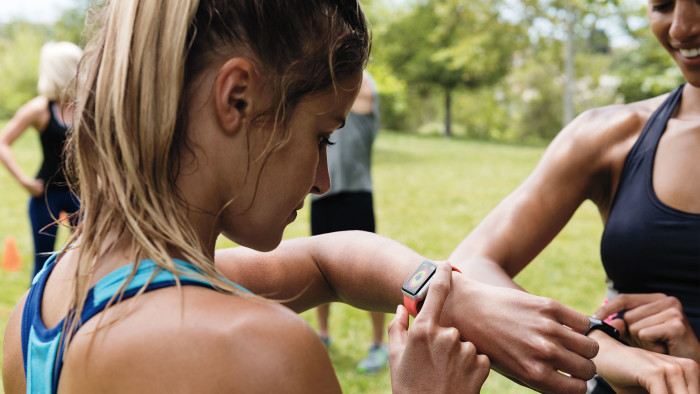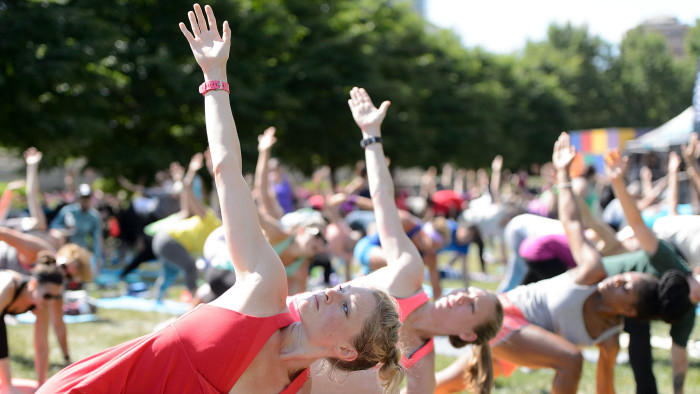Technology wearables are in workplace health vogue

Roula Khalaf, Editor of the FT, selects her favourite stories in this weekly newsletter.
As an outdoor clothing company based in Southern California, Patagonia does not need to do much to encourage its employees to be healthy. Its founder, Yvon Chouinard, wrote a memoir entitled Let My People Go Surfing — and surf they do, with some perfect beach and waves right in front of their offices in Ventura.
“Patagonia approaches wellness differently than almost any company that I’ve seen,” says Dean Carter, who joined the company as vice-president of human resources a year ago, after stints at Sears, the department store group, and watchmaker Fossil. “We don’t have a wellness director or programme. There are no ‘Eat Broccoli’ signs around the building. It is so embedded into what we do.”
Yet when it comes to fitness tracking, Carter says he has a “fascination” with wearable devices such as Fitbit. Typically associated with people who need to get more exercise rather than the outdoor types who work at Patagonia, he believes that health-monitoring technology could be used to measure broader activity and health levels of his workforce.
What it can do “is get a digital imprint of what wellness looks like”, he says. “Is the organisation stressed out? What is the positive endorphin release of a morning of surfing and how long does that last? That’s really interesting to me.”
Patagonia has not yet bought any fitness trackers for its staff but a growing number of companies are investing in wearable technology as part of their corporate wellness programmes. After Fitbit, the market leader in such wearables, began to offer its internet-connected wristbands and step counters to businesses six years ago, its group health division had raised its number of customers to more than 1,000 in 2015. These included 70 of the Fortune 500.
“What we give [employers] is access to real-time data on a corporate dashboard to get visibility into the health of [their employees],” says Amy McDonough, who runs the Fitbit’s group health division. Managers can break that information down by location or department and set tasks — either competitive or co-operative — to motivate employees, for example, to move more.
Other tech companies are eyeing the market. Apple has bolstered its sales team and is working with corporate wellness groups to incorporate its Watch into employers’ workplace health schemes. “The explosion of what are now known as wearables and smartwatches”, says Tal Gilbert, the Vitality Group’s chief product officer, has generated “new ways of getting into people’s day to day lives and encouraging them to be more active”.
Technology analyst group Gartner forecasts that by 2018, some 2m people will be required by their employer to wear fitness trackers. In particular these will include groups like firefighters, paramedics, industrial workers and airline pilots, where monitoring such as health, sleep and stress levels is critical to their safety and performance.
Not every employer has such a pressing incentive to manage the health of their workforce but sometimes even something as simple as encouraging office workers to get up from their desks can be enough to prompt an investment in wearable technology.
“One of the challenges is that our employees sit all day,” says Jason Russell of software giant SAP, who has a responsibility for promoting to employees the benefits of workplace wellness. He says he was alarmed by research last year that claimed “sitting is the new smoking” in terms of its potential effect on health.
SAP recently offered its staff the opportunity to buy a subsidised Fitbit tracker. “We didn’t want to make it completely free,” says Russell.
“But at the end of the day we wanted to encourage people to participate.” More than 2,500 employees signed up in the first week and he says the company is on course to easily beat its target of enrolling 20 per cent of SAP’s north American organisation in the scheme. “Being a data-driven tech company, from a demographics standpoint we think it’s going to connect with our employees.”
SAP is one of a growing number of companies that hope they may eventually be able to improve their staff’s health enough to lower healthcare costs. Russell admits, however, that “measuring that over a long time is definitely challenging.”
Others might put it in stronger terms. Without better integration of these consumer devices into medical systems at hospitals or doctors’ surgeries, using wearables in wellness schemes is “just a facade”, says Yuri Teshler, healthcare practice head at high tech consultants Moor Insights & Strategy. In other words, it is no good if, for example, data on how many steps a person has taken stay in the HR department when the rest of their health information is with their doctor.
“The only people it works for are the people who don’t need it,” Teshler adds. Indeed, a 2014 study by US non-profit group Rand, found that only between one- to two-fifths of eligible employees typically participate in corporate wellness schemes.

Healthier and wealthier staff are those more likely to do so. “Wearables have done very little to change the behaviour of those individuals they actually need to change. Part of the reason is nobody is looking at the problem holistically.”
In essence, broader approaches are needed as companies experiment with ways to ensure that employees — especially the least healthy ones — become and stay motivated to use the wearables. Some corporate wellness schemes offer financial incentives to encourage usage of fitness trackers, such as Amazon vouchers or the opportunity to win prizes if they pass a certain step count.
BP gives employees a lower-deductible on their health plan if they walk 1m steps in a year, validating the results using trackers.
At SAP, Russell hopes that the community aspect of Fitbit — which lets users compete on weekly tasks or continuing daily step counts with both colleagues and friends outside work — will encourage greater use. “What we are hoping is the natural competitive spirit comes out in people,” he says.
At Patagonia, Carter believes that a healthy office culture, however, requires more than just a wristband. “I’m excited about what technology can bring but you have to start with the community,” he argues. “If you are trying to get a Fitbit to drive the wellness programme, it’s putting the cart before the horse.”
Privacy concerns are hard to shake off
For employers, the idea of a dashboard giving them a view of the activity and sleep levels of their staff may sound like a novel insight into the inner workings of their company. However, staff members are not always keen to share intimate health details with their managers.
“One of the biggest issues is that employees don’t like to enrol into these [corporate wellness] systems because they don’t want to be monitored. That’s a massive barrier,” says Yuri Teshler, at analysts Moor Insights & Strategy.
He adds that even inside large healthcare systems and multibillion-dollar hospital networks, employees do not trust workplace health programmes that use wearables to collect personal data.
“They are petrified,” he says. “They know that your health data is more valuable than your financial data.” If even the people who are on the front line of healthcare do not want to hand over their personal information, he says, “that tells you something.”
Amy McDonough, vice-president of Fitbit group health, says the fitness tracking company treats privacy as “paramount”.
“Any employee who participates in the programme has actively consented to share a subset of the data collected by Fitbit with their employer,” she says. This includes steps, distance moved, active minutes and floors climbed. Sleep data is available only in aggregate, stripped of any individually identifying information. “We recommend that employers only get the amount of data they need.”
McDonough adds that two-thirds of employers are willing to share wearable data with employers in exchange for better programmes or lower healthcare costs.
At corporate wellness provider Vitality, employees gain points depending on how much exercise their fitness trackers show they have been doing. These points are then turned into airline-style “status” and it is this broader metric, not precise step counts, that managers can see.
“They see that John is ‘gold’ [status], not how John got to ‘gold’,” says Tal Gilbert, Vitality’s chief product officer. “We are not marketing or selling that data.” Although as he adds: “I’m not sure everyone in this space is taking that view.”
Comments